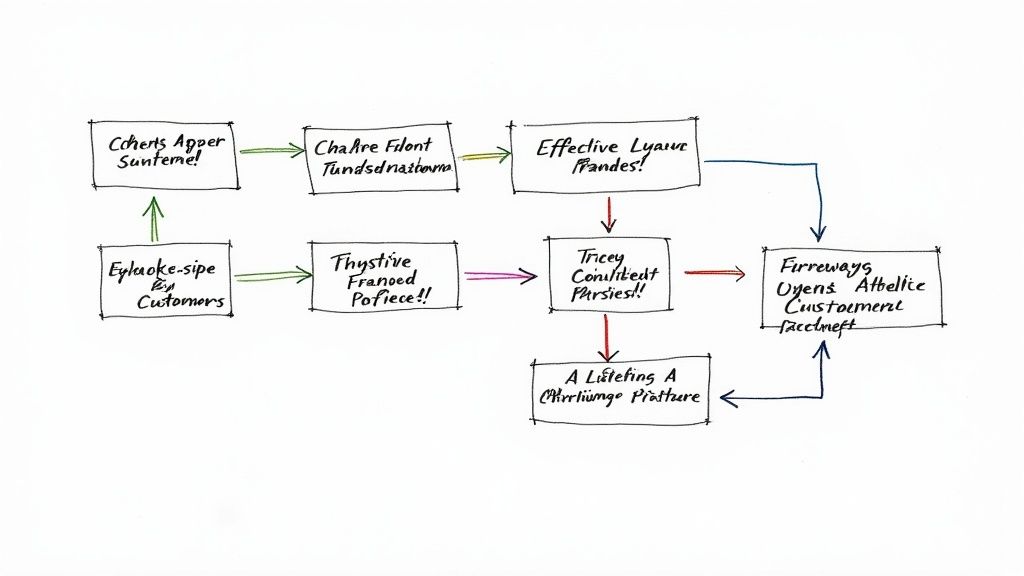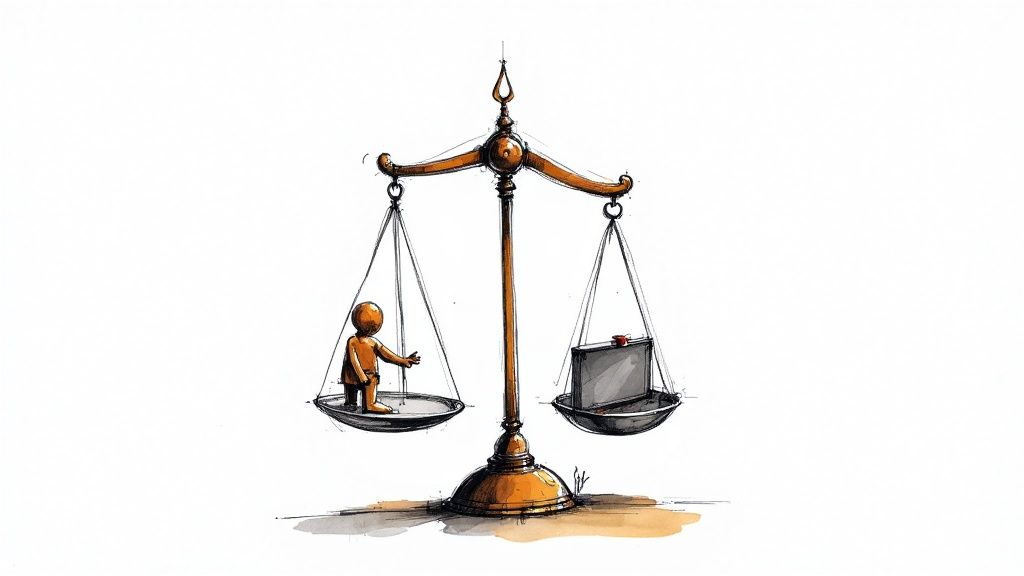How to Handle Difficult Customers: Growth Playbook
Why Traditional Customer Service Approaches Are Failing

The way customers interact with businesses has changed dramatically, but many companies haven't kept pace. Old-school customer service approaches - waiting on hold, repeating information to multiple agents, getting generic responses - simply don't work anymore. The numbers tell a concerning story: U.S. companies lose $1.6 trillion each year when frustrated customers take their business elsewhere after poor service experiences. This reality check shows why businesses need fresh solutions for handling difficult customer situations.
The Rise of the Silent Churner
Most unhappy customers never say a word - they just leave. Research shows that for every customer who complains, 25 others stay quiet about their frustration. Think of it like a restaurant where only one diner mentions their overcooked meal, while 25 others simply never return. This silent departure makes it nearly impossible to spot and fix problems before they impact the bottom line. What's more, the few customers who do speak up tend to spread the word far and wide - 13% share their bad experiences with 15 or more people, causing lasting damage to a company's reputation.
The Speed Imperative and Multi-Channel Frustration
Quick responses aren't just nice to have anymore - they're essential. About 90% of customers want their problems solved right away, and 60% expect an answer within 10 minutes. Meeting these expectations gets even harder when customers use multiple channels to reach out. A full 72% of people hate having to explain their issue repeatedly to different representatives, which often happens when companies use disconnected communication systems. Add to this that 62% of customers want support across email, chat, and social media, and it's clear why old single-channel approaches fall short. Learn more in our article about customer journey mapping examples for improving user experience and growth.
Empowering Teams with the Right Tools
Meeting modern customer needs requires more than just good intentions - it takes the right tools and strategies. Support platforms like Zendesk help teams manage customer conversations across channels, while AI chatbots from companies like sitebot provide instant, personalized responses around the clock. These tools help bridge the gap between what customers expect and what traditional approaches can deliver. By giving support teams better ways to handle difficult situations, companies can turn challenging interactions into opportunities to build stronger customer relationships. The goal isn't just to solve problems - it's to create positive experiences that keep customers coming back.
Understanding the Modern Customer Mindset

Helping your team handle difficult customers starts with understanding what drives customer behavior and expectations. Think about your own experiences - when you've been frustrated with a company, was it just the initial problem that bothered you, or was it how the company responded? Often, it's the response that matters most. By understanding these underlying motivations, teams can better address challenging situations.
The Expectation of Immediacy and Personalization
Quick responses and individualized attention have become standard expectations for customers. Recent studies show that 90% of people want their issues solved right away, with 60% expecting a reply within 10 minutes. Long wait times and having to repeat information to different representatives are common triggers for frustration. Generic responses only make things worse - customers want to feel that companies understand their specific situation and care about helping them. This means training teams to listen carefully and respond with empathy while working efficiently to find solutions.
The Multi-Channel Maze
Customers now connect with businesses through many different channels - from email and chat to social media and phone calls. While 62% of people appreciate having multiple ways to get support, this creates real challenges for businesses. A clear pain point emerges from the data: 72% of customers feel frustrated when they have to explain their problem multiple times across different channels. Tools like sitebot can help by integrating with platforms like Zendesk to keep customer information organized across channels. This allows support teams to maintain context and provide consistent help no matter how customers reach out.
Turning Frustration into Opportunity
When handled well, difficult situations can actually strengthen customer relationships. Research shows that 83% of customers become more loyal to brands that successfully resolve their complaints. The key is to treat each interaction as a chance to show customers you care by truly listening, understanding their perspective, and finding real solutions to their problems. Rather than seeing difficult customers as a burden, view their feedback as valuable input that can help improve your products and services. By learning from these experiences, you can create better ways to serve your target audience.
Building a Responsive Service Framework
After examining shifts in customer expectations and the gaps in traditional support methods, it's clear that effectively handling difficult customers requires a well-planned, adaptable approach. The goal is to create a system that both predicts customer needs and gives your team the tools to deliver great service, even in challenging situations.
The Importance of Immediate Resolution
Studies show that 90% of customers want their issues resolved quickly. This key finding shapes how we should build our service systems around speed and clear communication. While "immediate" doesn't mean instant, it does mean quickly acknowledging the issue and explaining what happens next. For example, sending a quick email to confirm you've received their complaint or using a chatbot to answer basic questions right away can help reduce frustration. Tools like sitebot work well for these first responses, which lets your team focus on more complex problems. Read also: Revolutionizing Customer Service: Creating Your Own GPT Chatbot to learn more about using AI chatbots in customer service.
Prioritization and Workflow Efficiency
Creating an effective service system means having clear ways to rank customer issues by importance. Since not every problem needs the same level of urgency, using a tiered system helps ensure the most pressing issues get immediate attention. For instance, you might label system outages affecting many users as "high priority" while marking general questions as lower priority.
| Priority Level | Issue Type | Response Time Target |
|---|---|---|
| High | Service outage, critical bugs | Within 1 hour |
| Medium | Feature requests, billing inquiries | Within 24 hours |
| Low | General inquiries, feedback | Within 48 hours |
Setting up smooth workflows also makes solving problems easier. Using a customer service platform like Zendesk keeps all customer conversations in one place, so your team can access relevant information quickly. This prevents customers from having to explain their situation multiple times, which often leads to frustration.
Maintaining Service Excellence Under Pressure
Even with good systems in place, dealing with upset customers can be challenging. Your team needs proper training and resources to handle difficult situations well. This includes teaching them proper communication methods, ways to resolve conflicts, and giving them access to answers for common customer questions. When staff members feel prepared, they can turn tough conversations into chances to build stronger customer relationships. By focusing on both the practical parts of service delivery and showing empathy to customers, you can build a responsive system that helps your business grow.
Creating Seamless Multi-Channel Experiences

Modern customers connect with businesses across multiple channels - email, social media, chat, and phone. This creates a key challenge when handling difficult customers: maintaining quality service across every touchpoint. Recent data shows that while 62% of customers want support through multiple channels, 77% of companies find it hard to deliver consistent experiences. This gap often leads to customer frustration.
The Pitfalls of Disconnected Systems
Picture this common scenario: A customer starts a live chat about a faulty product but doesn't get their issue fully resolved. When they follow up by email later, they have to explain everything again to a new support agent. No wonder 72% of customers get annoyed when they need to repeat their story multiple times. These disconnected communication systems make it especially hard to help upset customers effectively. When context gets lost between channels, it wastes time and only makes customers more frustrated.
Building Bridges with Unified Communications
The fix? Bringing all customer interactions into one central system. Modern platforms can connect support tickets from Zendesk, social media messages, and live chat through tools like sitebot - giving support teams the full picture of each customer's history. With this shared context, agents can see past conversations, understand the customer's state of mind, and respond in a more personal way. This prevents customers from having to repeat themselves and shows them you truly care about solving their problems.
Preventing Information Silos: A Proactive Approach
But unified systems are just the start. Companies also need to actively share information between departments. For instance, if someone complains about billing on social media, the billing team should see that right away - no more making customers repeat their issues. Simple tools like shared knowledge bases and team chat help information flow freely. When everyone has quick access to customer details, they can provide better, more consistent support no matter which channel they're using.
Building on Previous Conversations: The Power of Continuity
Good multi-channel service means more than just seeing past interactions - it means using that history wisely. Each conversation should help you better understand what customers need and how they prefer to communicate. If someone mentions they prefer email updates, note that preference and stick to it across all channels. This attention to detail shows respect and makes customers feel valued. By building on what you learn in each interaction, you can turn difficult situations into opportunities to strengthen relationships and build long-term loyalty.
Converting Critics into Champions
When customers are unhappy despite your best efforts at providing great service, you need effective strategies to turn the situation around. The good news is that difficult customer interactions present valuable opportunities to build stronger relationships. Studies show that 83% of customers become more loyal after a company successfully handles their complaints. This means every challenging situation has the potential to create a devoted customer.
The Power of Follow-Up: Beyond the Initial Resolution
Solving the initial problem is just the beginning. Making a real connection requires thoughtful follow-up to ensure customers are completely satisfied. Something as simple as sending an email asking "How is everything working now?" shows you care and gives customers a chance to raise any remaining concerns. This proactive outreach often reveals underlying issues that weren't obvious at first, helping you prevent similar problems in the future. Tools like sitebot can help automate these follow-up communications without overwhelming your team.
Preventing Recurring Issues: Turning Feedback into Action
Difficult customers often highlight important areas where you can improve. By examining what caused their complaints, you can spot patterns and fix systemic problems before they affect others. This might mean updating product features, making instructions clearer, or improving internal processes. When customers see you taking their feedback seriously and making real changes, it shows you truly value their input and are committed to serving them better.
Encouraging Customer Advocacy: Creating Raving Fans
When customers feel genuinely heard and valued, they're much more likely to recommend your business to others. Converting a negative experience into a positive one completely changes how they view your brand. Going above and beyond their expectations - perhaps with a thoughtful gesture of appreciation or early access to new features - demonstrates your commitment to their satisfaction and builds lasting goodwill.
Building a Framework for Success: A Proactive Approach
Turning critics into champions requires a systematic approach. Using a customer relationship management (CRM) platform like Zendesk helps track interactions and identify opportunities for follow-up. This allows you to group customers based on their feedback and customize your engagement accordingly. With clear processes in place, you can handle every difficult situation consistently and turn it into a chance to strengthen relationships. Over time, this builds a positive reputation and sustainable growth through genuine customer loyalty.
Empowering Your Team for Excellence

Creating an exceptional customer service team takes more than just basic training. Your staff needs a supportive environment, practical tools, and proven strategies to handle difficult customers effectively. Research shows that 73% of customers stay loyal to brands because of positive interactions with staff members. Let's explore how you can help your team deliver outstanding service consistently.
Training for Empathy and Effective Communication
The foundation of great customer service lies in developing essential interpersonal skills. While scripts and procedures matter, the real key is teaching your team how to connect with customers on a human level. Active listening plays a vital role - your staff should focus on understanding both the specific issue and the customer's emotions. For example, they might say "I hear how frustrating this problem has been for you, and I'm committed to finding a solution." Our detailed customer service training guide offers more tips for building these crucial skills.
Your team also needs practical techniques for handling tense situations. This includes learning to use positive language and turn complaints into constructive conversations. When a customer says "This product doesn't work at all!" a skilled rep might respond "Let's figure out exactly what's not working so I can help you get the best results." These communication strategies help keep discussions productive and solution-focused.
Providing the Right Tools and Resources
Even the most skilled customer service team needs proper support tools to succeed. Quick access to detailed product information and FAQs helps staff answer questions efficiently - something 90% of customers say is a top priority. A robust platform like Zendesk keeps all customer history in one place, making it easy to provide personalized help based on past interactions.
Adding an AI assistant like sitebot can handle routine questions automatically, giving your team more time for complex issues that need human attention. Since 60% of customers want answers within 10 minutes, this combination of AI and human support helps meet those expectations while maintaining service quality.
Building Resilience and Emotional Management
Dealing with upset customers takes an emotional toll over time. Help your team stay balanced by teaching stress management techniques and providing mental health resources. Consider offering workshops on emotional intelligence or access to counseling services. When staff members feel supported, they're better equipped to stay calm during difficult interactions and maintain their enthusiasm for helping customers. This creates better outcomes for everyone and helps prevent burnout in your team.
Want to give your customer service team an AI-powered advantage? Learn how sitebot can help them deliver better support while reducing their workload.


